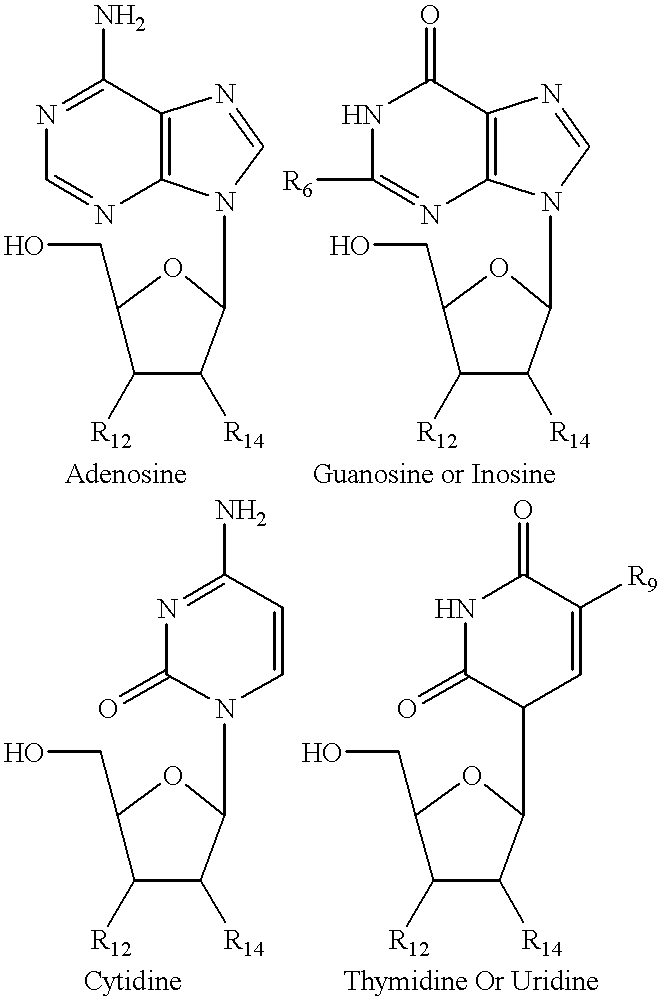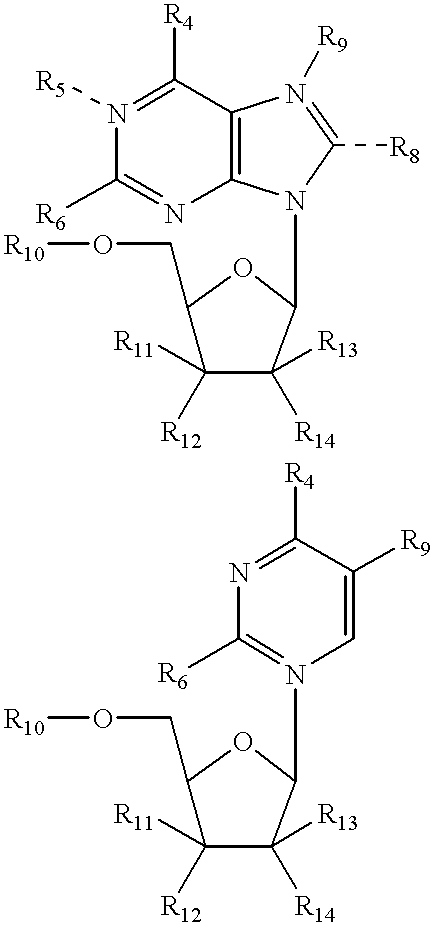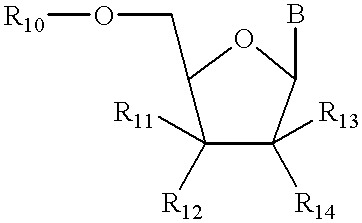Structural analogs of amine bases and nucleosides
a technology applied in the field of structural analogs of amine bases and nucleosides, can solve the problems of affecting the stability of amine bases
- Summary
- Abstract
- Description
- Claims
- Application Information
AI Technical Summary
Benefits of technology
Problems solved by technology
Method used
Image
Examples
example 1
Preparation of 2'-Deoxy-5-N-ethylmaleimidouridine
A solution of 2'-deoxyuridine (2.28 grams, 10 mmol) and mercuric acetate (3.19 grams, 10 mmol) in 15 ml of water was heated with stirring at 60.degree. C. for 5 hours. After removal of acetic acid formed in the reaction and water in vacuo, the white residue was suspended with N-ethylmaleimide (3.76 grams, 30 mmol) and 110 ml of 0.1 M lithium tetrachloropalladate in methanol at 60.degree. C. for 12 hours. The mixture was cooled to room temperature, and a solution of hydrogen sulfide (850 mg, 25 mmol) in methanol (100 ml) was added with stirring, and filtered through Celite, and the solution was evaporated to dryness. The yellowish fluorescent solid residue was dissolved in methanol (100 ml) and suspended with 40 grams of silica gel, grade 9385, 230-40 Mesh, 60 A (Merck), and evaporated to dryness.
The coated silica was added on the top of a silica column (5.times.60 cm) using a solution of 10% methanol in dichloromethane as eluent and t...
example 2
Preparation of 5'-Dimethoxytrityl, 2'-deoxy, 5-N-ethylmaleimidouridine
To a cooled (0.degree. C.) solution of 2'-Deoxy-5-N-ethylmaleimidouridine (3.51 gm, 10 mmol) in 50 ml of dry pyridine with stirring, was added dropwise a solution of dimethoxytritylchloride (3.72 gm, 11 mmol) in 50 ml pyridine. After the addition, the reaction was left to warn gradually to room temperature, and stirring was continued for 12 hours. The pyridine was evaporated in vacuo and the resulting brown oil was dissolved in ethyl acetate (200 ml) and washed with water (2.times.200 ml), followed by washing with a saturated aqueous sodium chloride solution, and the organic phase was dried with anhydrous sodium sulfate. The solvent was removed under vacuo and the crude brown oil was purified on silica gel column (4.times.80 cm) with 5%-methanol / 0.5% pyridine in dichloromethane as eluent. The appropriate fraction was collected and evaporated to dryness.
Rf: 0.54.
.sup.1 H-NMR-[CDCl3] 9.00 (s, 1H, vinylmaleimide), 7....
example 3
Preparation of 2'-deoxy, 5'-dimethoxytrityluridine, 3'-(allyl N,N-diisopropylphosphoramidite)
The reagent (allyloxy)bis(diisopropylamino)phosphine, is prepared according to Hayakawa et al. in J. Am. Chem. Soc. (1990), 112:1691. To a solution of 5'-Dimethoxytrityl, 2'-deoxy, 5-N-ethylmaleimidouridine (6.03 gm, 9.25 mmol) in dichloromethane (60 ml), was added diisopropylamine (1.43 ml, 10.2 mmol), (allyloxy)bis(diisopropylamino)phosphine (4.3 ml, 14.0 mmol), and 1H-tetrazole (715 mg, 10.2 mmol). After 1.5 hours of stirring at 25.degree. C., the mixture was poured into ethyl acetate (300 ml), washed with brine, and dried over Na.sub.2 SO.sub.4. The resulting solution was concentrated to give a gummy material, which was dissolved in ethyl acetate (20 ml). The solution was added dropwise into hexane (800 ml) at -78.degree. C. with stirring to give a powder, which was collected under vacuo through a paper filter (Watman #1) using a Buchner funnel. The resulting cake was dried under high va...
PUM
| Property | Measurement | Unit |
|---|---|---|
| Structure | aaaaa | aaaaa |
| Acidity | aaaaa | aaaaa |
Abstract
Description
Claims
Application Information
 Login to View More
Login to View More - R&D
- Intellectual Property
- Life Sciences
- Materials
- Tech Scout
- Unparalleled Data Quality
- Higher Quality Content
- 60% Fewer Hallucinations
Browse by: Latest US Patents, China's latest patents, Technical Efficacy Thesaurus, Application Domain, Technology Topic, Popular Technical Reports.
© 2025 PatSnap. All rights reserved.Legal|Privacy policy|Modern Slavery Act Transparency Statement|Sitemap|About US| Contact US: help@patsnap.com



